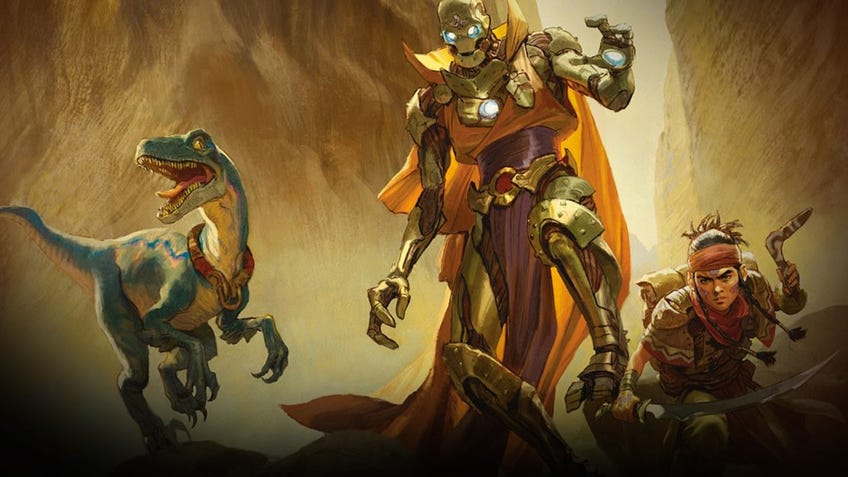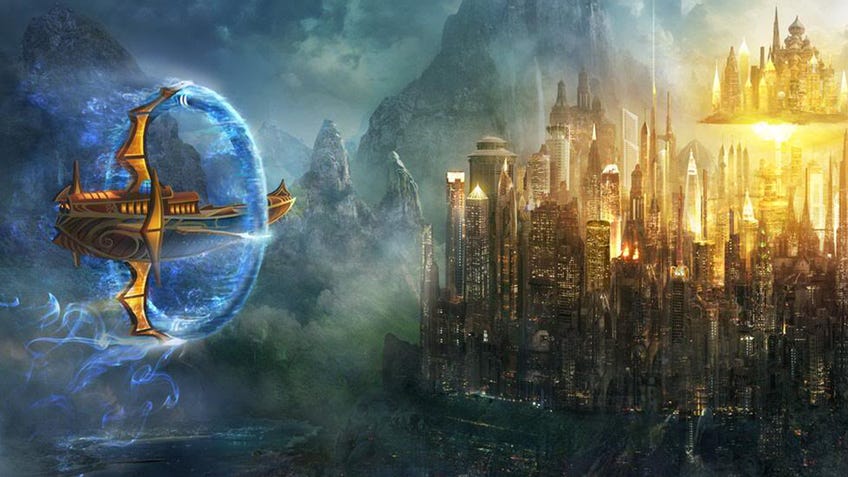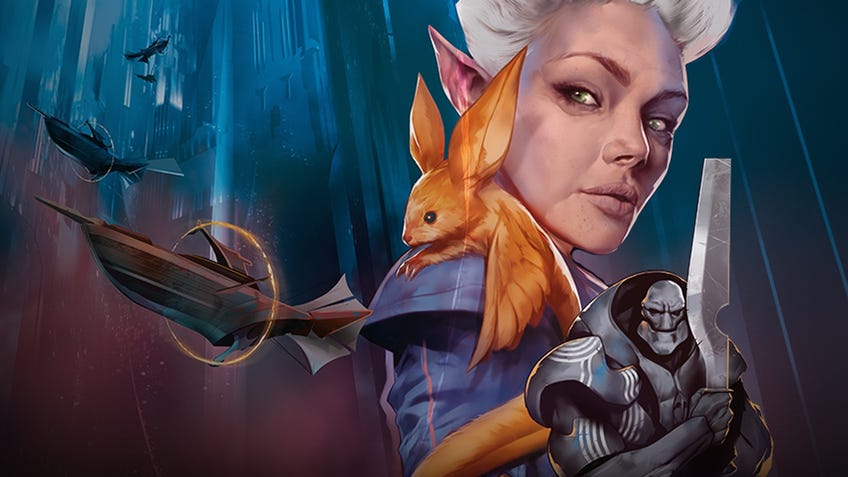Dungeons & Dragons 5E: Eberron - Rising From the Last War lead designer takes us on a magic-powered airship ride through divided lands and the remnants of war
Full steam ahead.
You traipse through the dead-grey mists, just outside where the beautiful city of Cyre once shone so bright. In the distance a clockwork town carries on, its inhabitants long gone. Somewhere beneath you colossal constructs lie inactive.
This is the Mournland, a razed waste in Dungeons & Dragons 5E campaign setting Eberron.
No place in the region captures the atmosphere of Eberron quite as well as the Mournland, with its landscape littered with magical storms, mutated monsters and the corpses of thousands of soldiers - their bodies frozen in freshness, unable to decompose. It’s the shared loss of Eberron, the leftovers of a mysterious blast of unknown origin so catastrophic it ended the war.
“The shadow of a century-long war hangs over all the events of the present,” says James Wyatt, one of the lead designers on 2019’s Eberron: Rising from the Last War Dungeons & Dragons 5E sourcebook.
“Old grudges linger, national ties remain important, the threat that hostilities could reignite hangs overhead and the devastation of the Mournland marks the continent like a wound that refuses to heal.”
There’s a moral ambiguity to the setting, Wyatt adds; it can be hard to determine if even the gods are good and corruption runs rife through the mortal institutions of Eberron, from its churches right up to the government.
Beyond the choked reaches of the mist is the city of Sharn, its vast skyscrapers connected by a sparkling lightning rail. Airships veer overhead, while far-off lands hold halfling dinosaur riders and terrible demons alike.
To see the world of Eberron in action, watch the first season of Dicebreaker’s Dungeons & Dragons 5E series Dungeonbreaker.
As much was lost in Eberron’s own Great War, there was also much created in its aftermath. In the toxic reaches of the Mournland so deadly to organic creatures, members of new player character race the Warforged roam.
“They are artificial people, crafted by artificers in magical forges to serve as soldiers in the Last War - and now that the war is over, they’re trying to figure out who they are and what they’re supposed to do in a world at peace,” says Wyatt.
Old grudges linger, national ties remain important, the threat that hostilities could reignite hangs overhead and the devastation of the Mournland marks the continent like a wound that refuses to heal.”
“Some of them are settling in and trying to live out their lives as ordinary citizens. Some of them are having a harder time adjusting. Some of them face terrible prejudice, and some of them want vengeance against the fleshy races that would treat them as tools and weapons, rather than people.”
Some Warforged have taken to wandering the Mournland under the tutelage of the Lord of Blades - a charismatic Warforged who wants to destroy and enslave all flesh races. Like the beleaguered inhabitants of robotic theme park Westworld, the Warforged have every reason to be livid.
“Some people imagine the Warforged as robots and approach them much like you’d treat androids in a science-fiction setting,” says Wyatt. “For me personally, I’m most intrigued by the Warforged as people who happen to have artificial bodies, but whose hearts and minds and souls are capable of the same range of thought and emotion and spirituality as anyone else.”

Although their insides are made of metal and blood tubes, the Warforged experience pain and fear. They adopt hobbies; usually repetitive, like knitting. Despite their peacefulness, many of the humans of Eberron’s five nations see them as mindless killing machines - a reminder of a terrible past.
The wired cosmos of Eberron and its people - flesh and steel alike - has been around since around 2003. Dungeons & Dragons publisher Wizards of the Coast’s first encounter with Eberron was as part of a great “setting search” held in 2002, which designer Keith Baker - who also created card game Gloom - won.
“Recognising that there’s tremendous creativity in the legions of dungeon masters out in the world beyond our walls, we put out a call for world proposals,” says Wyatt. “We received some ridiculous number of one-page pitches - I want to say like 13,000, but my memory for numbers is not great! Anyway, Keith Baker’s proposal, ‘Thrilling Tales of Swords & Sorcery’, was one that rose to the top of that pile.”
Over the course of the next year, Thrilling Tales became Eberron. The first Eberron Campaign Setting book was released in June 2004 and saw multiple releases over the editions right up to 5E’s Rising from the Last War. As the first published setting created for Dungeons & Dragons’ third edition, Wyatt notes, Eberron was intended to be an expression of what modern D&D was.
“Perhaps surprisingly, the world hasn’t actually changed very much since then,” he explains. “A secret mission of the fourth edition version of the setting was to demonstrate that you could update your campaign from third edition to fourth edition without having to make drastic changes to the world.”
Like the beleaguered inhabitants of robotic theme park Westworld, the Warforged have every reason to be livid.

Eberron as a setting can be pitch black, a traipse through trauma and what it means to arise from it. Many of its inhabitants have chosen to descend into their darkest selves, scavengers in the ruins of a world marked by war: the petty criminals of the city, dubious government officials, sinister crime families and cults.
Others have hidden away, worshipping inscrutable terrors in long-razed ruins, or stowed away in underground laboratories, set on making weapons worse than the ones before by reviving Warforged colossi.
Some are driven to desperate measures, such as the people of Karrnath, who joined religion The Blood of Vol to survive the war. Its new leader has shunned the dark faith, but must deal with the legions of undead still living and working in the city. Beyond the war, fiends lurk in the black-sand, lava-strewn plains of the Demon Wastes.
But not all hope is lost.
There is life here. Its denizens tinker and experiment, creating glorious artefacts of wonder. Its tailors weave magic into clothes, so that they can hold shimmering illusions like stars. One nation uses magic to animate its farming equipment.

Out on the plains, halfling warriors blaze through on dinosaurs with which they’ve developed a secret bond. Many of the places unashamedly veer toward pulp fantasy tropes. There’s an ancient city of dragons, a skull-shaped mountain peak and a frozen land where an archfey queen commands an army made of living ice.
“On the pulp side, I remember talking a lot about Indiana Jones - not just for the sake of over-the-top action, but also in thinking about the role of intercontinental travel in an Eberron campaign,” adds Wyatt. “The world reinforces these themes with its settings and villains, and in some heaping handfuls of dungeon master advice.”
It is a wide world, a place to uncover secret civilisations, infiltrate an empire ruled by psychic overlords and take down eerie cults. All spread across a map - an entire cosmos in fact - that is vast, but endlessly traversable in a way that the usual horse and portal-gate fantasy travel in standard Dungeons & Dragons 5E can’t match. In Eberron, magic-powered airships and trains zip across the skies and lands respectively.
Others have hidden away, worshipping inscrutable terrors in long-razed ruins, or stowed away in underground laboratories, set on making weapons worse than the ones before by reviving Warforged colossi.
“Fast travel means that it’s easier for players to experience the whole wide world in all its diversity - I can have my characters exploring the swamps of the Shadow Marches one week, and delving below the mountains of the Mror Holds the next, assuming that they had a smooth and uneventful trip across the continent in-between,” says Wyatt.
The designer observes that the airships and railways are ideal for pulse-pounding combat encounters or locked-room noir murder mysteries, exemplified well in unofficial Dungeons & Dragons 5E one-shot adventure Murder on the Eberron Express, inspired by the works of Agatha Christie.
Eberron is a place where magic is melded with steel, where objects of wonder shimmer and primordial magic shifts beneath vast airships. With its webs of intrigue and fast travel, it takes on a cinematic air. It exists separate from much of the overall Dungeons & Dragons universe, forging its own brazen world steeped in a kind of dungeonpunk vibe, where swashbuckling adventurers wielding savage technology fight distant, secret overlords.
It’s a cosmos that feels abandoned by its gods, where its inhabitants must work to forge a new faith outside of the ravages of war. Where outsiders - charlatans, tinkerers and outlanders - are the most likely to save the world as they understand its grief, unlike the officials and scavengers set on exploting its vulnerabilities. Eberron is a vast, new plain where magical powers grant as much gleaming wonder as they do potential annihilation.
Learn more about the next releases for Dungeons & Dragons 5E in our round-up of upcoming tabletop RPG releases 2020 or take a look at the best tabletop RPGS already available to play.










